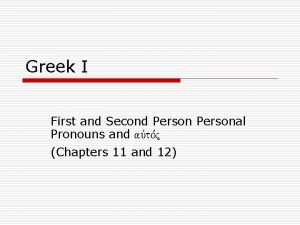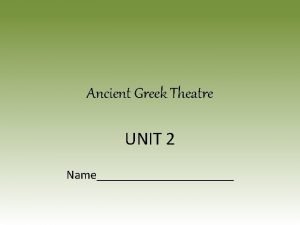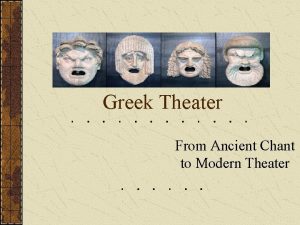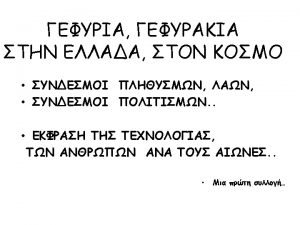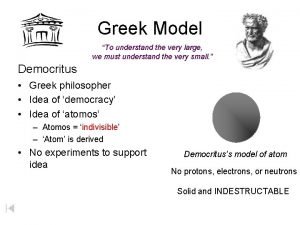Ancient Greek for Everyone A New Digital Resource















































- Slides: 47

Ancient Greek for Everyone: A New Digital Resource for Beginning Greek as taught at Louisiana State University Fall 2013 Richard Warga Unit 19: The Perfect System

Ancient Greek for Everyone This class (someday, Month ##, 2013) • AGE Unit 19: The Perfect System • You have learned four tenses of Greek verbs: the present, future, imperfect and aorist. • This Unit presents the final tenses, those of the Perfect System.

Elementary Greek The Perfect System • You have learned four tenses of Greek verbs: the present, future, imperfect and aorist. • The final tenses you learn differ from those you have already learned in “aspect. ” • The tenses of the “Perfect System” comprise those which refer to completed action. – The Latin word perfectum means “complete” and is the origin of the name of this set of tenses. It does not mean “flawless” or the like in the English sense of the word.

Elementary Greek • From Unit 13: The aorist tense of Greek verbs: – Both the imperfect and aorist tenses describe actions in the past. They differ in what is called “aspect. ” • The aorist conveys a single, discreet action. This is the more common, default tense for referring to action in the past. • The imperfect conveys activity that was more than a single action in some way. – For example: • “I walked. ” Aorist: think of a single image of the speaker in the act of walking. • “I was walking. ” Imperfect: think of an ongoing video of the speaker walking.

Elementary Greek The Perfect System – Greek tenses differ in what is called “aspect. ” • The aorist conveys a single, discreet action. This is the more common, default tense for referring to action in the past. • The imperfect conveys activity that was ongoing in some way. • The perfect states that an action is completed. – For example: • “I went. ” Aorist: the speaker travelled from point A to point B. • “I was going. ” Imperfect: the speaker was on the way from point A to point B. • “I have come. ” Perfect: the speaker has now arrived at point B.

Elementary Greek The Perfect System • Greek tenses of the perfect system use distinctive markers: – ALL verbs in the perfect system double the initial sound of the verb’s stem. This addition is called the “reduplication. ” – In the ACTIVE voice, verbs add the suffix –κα to the verb stem before any other ending. • When adding –κα to the verb stem is too difficult to pronounce, the –κ merges or drops out.

Elementary Greek The Perfect System • Greek tenses of the perfect system use distinctive markers: – ALL verbs in the perfect system double the initial sound of the verb’s stem. This addition is called the “reduplication. ” – λυ “loosen” • + reduplication λε- λελυ- (perfect stem) – δεικ “show” • + reduplication δε- δεδεικ- (perfect stem) – γραφ “write” • + reduplication γε- γεγραφ- (perfect stem)

Elementary Greek The Perfect System • Greek tenses of the perfect system use distinctive markers: – ALL verbs in the perfect system double the initial sound of the verb’s stem. This addition is called the “reduplication. ” – Greek verb stems starting with a vowel effectively add an augment: – ἀρχ “lead, rule, begin” • + reduplication ἐ- ἠρχ- (perfect stem) – ἐθελη “want” • + reduplication ἐ- ἠθελη- (perfect stem)

Elementary Greek The Perfect System • Greek tenses of the perfect system use distinctive markers: – ALL verbs in the perfect system double the initial sound of the verb’s stem. This addition is called the “reduplication. ” – Greek verbs will not duplicate an aspiration or a sigma: – θη “put, make” • + reduplication θε- τεθη- (perfect stem) – στη “stand” • + reduplication σε- ἑστη- (perfect stem)

Elementary Greek The Perfect System • Greek tenses of the perfect system use distinctive markers: – ALL verbs in the perfect system double the initial sound of the verb’s stem. This addition is called the “reduplication. ” – In the active voice, the perfect stem adds the marker –κα. – θη τεθη- (perfect stem) • + –κα τεθηκα- (perfect active stem) – στη ἑστη- (perfect stem) • + –κα ἑστηκα- (perfect active stem)

Elementary Greek The Perfect System • Greek tenses of the perfect system use distinctive markers: – ALL verbs in the perfect system double the initial sound of the verb’s stem. This addition is called the “reduplication. ” – In the active voice, the perfect stem add the marker –κα. When adding –κα to the verb stem is too difficult to pronounce, the –κ merges or drops out. – λυ λελυ- (perfect stem) • + –κα λελυκα- (perfect active stem) – δεικ δεδεικ- (perfect stem) • + –κα δεδειχα- (perfect active stem)

Elementary Greek The Perfect System • Greek tenses of the perfect system use distinctive markers: – ALL verbs in the perfect system double the initial sound of the verb’s stem. This addition is called the “reduplication. ” – In the active voice, the perfect stem add the marker –κα. When adding –κα to the verb stem is too difficult to pronounce, the –κ merges or drops out. – γραφ γεγραφ- (perfect stem) • + –κα γεγραφα- (perfect active stem) – ἀρχ ἠρχ- (perfect stem) • + –κα ἠρχα- (perfect active stem)

Elementary Greek • Although advanced vocabulary lists and lexica give six principal parts for Greek verbs, you are responsible for only the first three. For most reading purposes at the beginning and intermediate levels, these three are sufficient. • The fourth principal part in an advanced vocabulary list of six principal parts of Greek verbs will be the perfect active stem. • This principal part is given because this stem is not always completely predictable, with minor, but complex, variations. Be aware, too, that many verbs never occur (or are extremely rare) in perfect tenses, and so do not even have a fourth principal part. • If you understand the principles of building perfect stems, you should be able to recognize them when they appear.

Elementary Greek Building a Greek verb • The Perfect Tense is a primary tense and so uses a variation of primary endings: • - = I (1 st sg) -μεν = we (1 st pl) • -ς = you (2 nd sg) -τε = y’all (2 nd pl) • -ε = (s)he, it (3 rd sg) -σι = they (3 rd pl) These endings most closely resemble the -μι conjugation active part of the Primary Personal Endings on the Master List of Greek Endings.

Elementary Greek • λέλυκας • λέλυκε • λελύκαμεν • λελύκατε • λελύκασι Building a Greek Verb The Perfect Indicative Active of λύω (GPH p. 90)


Elementary Greek Building a Greek verb • In the middle voice, the Perfect Tense uses primary endings: • -μαι = I (1 st sg) -μεθα = we (1 st pl) • -σαι = you (2 nd sg) -σθε = y’all (2 nd pl) • -ται = (s)he, it (3 rd sg) -νται = they (3 rd pl) These endings are the standard ones from the Primary Personal Endings on the Master List of Greek Endings.


Elementary Greek • Although advanced vocabulary lists and lexica give six principal parts for Greek verbs, you are responsible for only the first three. For most reading purposes at the beginning and intermediate levels, these three are sufficient. • The fifth principal part in an advanced vocabulary list of six principal parts of Greek verbs will be the 1 st person singular perfect indicative middle. • This principal part is given because this form is not always completely predictable, with minor, but complex, variations. Be aware, too, that many verbs never occur (or are extremely rare) in perfect tenses, and so do not even have a fifth principal part. • If you understand the principles of building perfect stems, you should be able to recognize them when they appear.

Ancient Greek for Everyone CONSONANTS Labial Dental πp τt βb δd φ ph θ th ψ ps σs μm νn λl Palatal κ k = unvoiced γ g = voiced χ kh = aspirated ξ ks = + σ γκ, γγ, γχ, γξ ng nasals ρ r = liquids

Elementary Greek • δέδειγμαι • δέδειγξαι • δέδειγκται • δεδείγμεθα • δέδειγχθε • See section on periphrastic forms with participles. Notice that a final consonant of a verb stem (here -κ) assimilates to the initial sound of the personal ending. In practice, Greek avoided many forms that are difficult to pronounce and did not even try to say the third person plural form in this case (which would require somehow pronouncing *δέ-δεικ-νται). Building a Greek Verb The Perfect Indicative Middle of δείκνυμι

Elementary Greek Building a Greek verb • In the infinitive mood, the Perfect Tense the same endings as -μι verbs: • -ναι = active -σθαι = middle • λελυκέναι • δεδειχέναι λελυκέσθαι δεδειχέσθαι These endings are the same endings as for -μι verbs on the Master List of Greek Endings.

Elementary Greek From Unit 17: The present active participle The pattern for present active participles is present stem + ντ + –ς –σα –ν For -ω verbs, the combination with thematic vowel yields –ων –ουσα –ον • One of the most common and useful participles is the present active participle of εἰμί “be” • The masculine forms will be familiar from the noun ἄρχων, ἄρχοντος ὁ “ruler” in Unit 3. In fact, this word is actually a participle that was used so much it was also used as a noun.

Elementary Greek The perfect active participle The pattern for the present active participle of -ω verbs is present stem + –ων –ουσα –ον The pattern for the perfect active participle is present stem + –ώς –υῖα –ός The pattern of the perfect active participle is basically the same as for the present, except that the -ν- has dropped out.

Elementary Greek From Unit 17: The present active participle present participle active of εἰμί “be” masculine forms singular Nom. ὤν Gen. ὄντος Dat. ὄντι Acc. ὄντα plural Nom. ὄντες Gen. ὄντων Dat. οὖσι Acc. ὄντας nom. sg. : οντς ονς ων dat. pl. : οντσι ονσι ουσι

Elementary Greek The perfect active participle perfect participle active of λύω masculine forms singular Nom. λελυκώς Gen. λελυκότος Dat. λελυκότι Acc. λελυκότα plural Nom. λελυκότες Gen. λελυκότων Dat. λελυκόσι Acc. λελυκότας nom. sg. : οτς ως dat. pl. : οτσι οσι

Elementary Greek From Unit 17: The present active participle present participle active of εἰμί “be” feminine forms singular Nom. οὖσα Gen. οὔσης Dat. οὔσῃ Acc. οὖσαν plural Nom. οὖσαι Gen. οὐσῶν Dat. οὔσαις Acc. οὔσας These are the same endings used by δόξα –ης ἡ “glory, judgment, opinion” in Unit 8

Elementary Greek The perfect active participle perfect participle active of λύω feminine forms singular Nom. λελυκυῖα Gen. λελυκυίας Dat. λελυκυίᾳ Acc. λελυκυῖαν plural Nom. λελυκυῖαι Gen. λελυκυιῶν Dat. λελυκυίαις Acc. λελυκυίας Compared to the present active participle, these forms have -υι- instead of -ουσ-

Elementary Greek From Unit 17: The present active participle present participle active of εἰμί “be” neuter forms singular Nom. ὄν Gen. ὄντος Dat. ὄντι Acc. = nom. plural Nom. ὄντα Gen. ὄντων Dat. οὖσι Acc. = nom. sg. : οντ ον dat. pl. : οντσι ονσι ουσι

Elementary Greek The perfect active participle perfect participle active of λύω neuter forms singular Nom. λελυκός Gen. λελυκότος Dat. λελυκότι Acc. λελυκός plural Nom. λελυκότα Gen. λελυκότων Dat. λελυκόσι Acc. λελυκότα nom. sg. : οτ ος dat. pl. : οτσι ωσι

Elementary Greek • οἶδα • οἶσθα imperative: ἴσθι • οἶδε • ἴσμεν • ἴστε • ἴσασι infinitive: εἰδέναι participle: εἰδώς –υῖα –ός This verb is an irregularly formed perfect tense from the stem ἰδ-, which means “see” (the root of which also serves as the aorist for ὁράω “see”). In the perfect οἶδα literally means “have seen” but it regularly means “know” (in the sense that what you have seen you know and understand). Building a Greek Verb The Perfect Active of οἶδα (GPH p. 166)

Elementary Greek From Unit 17: Middle participles • All participles in the middle voice have the marker -μεν-. • All participles in the middle voice use –ος –η –ον endings. • In other words, wherever the personal ending (or infinitive ending) would be, substitute: –μενος –μένη –μενον


Elementary Greek • In all languages, ideas that are complex or unorthodox are sometimes expressed with a combination of words, even when a single word might technically cover the same meaning. Such combinations of words are called “periphrastic” (< Greek περίφρασις “talking around”). • Both Greek and English lack single verb forms that are simultaneously, and unambiguously, both perfect tense and passive voice. Both languages use combinations of a participle and auxiliary verbs to convey the perfect passive. • Even when Greek has a perfect tense in the middle voice that can be pressed into service as a passive, it is not unusual to use the periphrastic construction instead.

Elementary Greek The Perfect System • Greek often expresses the passive of the perfect system using periphrastic constructions: ὁ νόμος γέγραπται. or ὁ νόμος γεγραμμένος ἐστιν. “The law has been written down. ” “The law is written down. ” οἱ νόμοι γεγραμμένοι εἰσιν. “The laws have been written down. ” “The laws are written down. ”

Elementary Greek The Perfect System • Greek tenses differ in what is called “aspect. ” • The perfect states that an action is completed. • The pluperfect states that an action was completed in the past. The Latin plus perfectum means “more complete, ” the origin of the name of this tense. • For example: • “I have come. ” Perfect: the speaker has now arrived. • “I had come. ” Pluperfect: the speaker arrived some time in the past.

Elementary Greek The Perfect System – The pluperfect tense, like the imperfect, exists only in the indicative mood. – Like any tense that refers to an historical event in the (indicative) past, the pluperfect adds an augment prefixed to the (perfect) stem.

Elementary Greek Building a Greek verb • The Pluperfect Tense is a secondary tense and so uses a variation of secondary endings: • -η = I (1 st sg) -εμεν = we (1 st pl) • -ης = you (2 nd sg) -ετε = y’all (2 nd pl) • -ει = (s)he, it (3 rd sg) -εσαν = they (3 rd pl) These endings most closely resemble the -μι conjugation active part of the Secondary Personal Endings on the Master List of Greek Endings.

Elementary Greek • ἐλελύκης • ἐλελύκει • ἐλελύκεμεν • ἐλελύκετε • ἐλελύκεσαν Building a Greek Verb The Pluperfect Indicative Active of λύω (GPH p. 91)

Elementary Greek • ᾔδη or ᾔδειν • ᾔδησθα or ᾔδεις • ᾔδει(ν) • ᾖσμεν or ᾔδεμεν • ᾖστε or ᾔδετε • ᾖσαν or ᾔδεσαν This verb is an irregularly formed pluperfect tense from the stem εἰδ-, which means “see” (the root of which also serves as the aorist for ὁράω). The pluperfect literally means “had seen” but it regularly means “knew” (in the sense that what you had seen you knew and understood). Building a Greek Verb The Pluperfect Active of οἶδα (GPH p. 166)

Elementary Greek Building a Greek verb • In the middle voice, the Pluperfect Tense uses secondary endings: • -μην = I (1 st sg) -μεθα = we (1 st pl) • -σο = you (2 nd sg) -σθε = y’all (2 nd pl) • -το = (s)he, it (3 rd sg) -ντο = they (3 rd pl) These endings are the standard ones from the Secondary Personal Endings on the Master List of Greek Endings.


Elementary Greek The Perfect System • Greek often expresses the passive of the perfect system using periphrastic constructions: ὁ νόμος ἐγέγραπτο. or ὁ νόμος γεγραμμένος ἦν. “The law had been written down. ” “The law was written down. ” οἱ νόμοι γεγραμμένοι ἦσαν. “The laws had been written down. ” “The laws were written down. ”

Elementary Greek • A Greek verb by itself usually communicates FIVE pieces of information: – – – Person: 1 st, 2 nd, 3 rd Number: singular, plural Tense: present, future, imperfect, aorist, perfect, pluperfect, Mood: indicative, infinitive, imperative, participle Voice: active, middle

Elementary Greek Classical Vocabulary • δέδοικα (or shortened to δέδια) fear • ἔοικα resemble, seem • οἶδα know These verbs exist only in the Perfect System. Except for the forms of οἶδα given earlier, they are regular, just lacking tenses outside the Perfect System.

Elementary Greek New Testament Vocabulary (defective) • οἶδα know In later Greek like the Koine of the NT, the plural forms of the perfect of this verb are regularized to οἴδαμεν, οἴδατε, οἴδασι (in contrast to the forms given earlier for Classical Greek).

Elementary Greek • Next class (someday, Month ##, 2013) – Unit 19 Biblical reading. – Unit 19 Classical reading. – Be able to: • read the sentences aloud • parse each verb, noun and pronoun • translate the sentences into English.
 Ancient greek for everyone
Ancient greek for everyone Ancient greek for everyone
Ancient greek for everyone Good afternoon everyone formal
Good afternoon everyone formal Publik sektor
Publik sektor ᾔει
ᾔει Resource loading vs resource leveling
Resource loading vs resource leveling Contoh resource loading
Contoh resource loading Everyone dancing merrily in the new old fashioned way
Everyone dancing merrily in the new old fashioned way New deal everyone
New deal everyone Pictures of ancient and modern means of communication
Pictures of ancient and modern means of communication Ancient india vs ancient china
Ancient india vs ancient china Ancient greek vowels
Ancient greek vowels Prostas house
Prostas house English georgian period floral design
English georgian period floral design Theatron greek theatre definition
Theatron greek theatre definition Ancient egyptian floral arrangements
Ancient egyptian floral arrangements Ancient greece theatre masks
Ancient greece theatre masks Ancient pronouns
Ancient pronouns Greece on a map
Greece on a map Map of ancient greece and surrounding areas
Map of ancient greece and surrounding areas Greek theater costumes
Greek theater costumes Theatre masks name
Theatre masks name Ancient greek music facts
Ancient greek music facts Ancient greek theater masks
Ancient greek theater masks Values of ancient greece
Values of ancient greece Greece geography
Greece geography Greek words in english
Greek words in english Ancient greek olympics primary sources
Ancient greek olympics primary sources Ancient greek theater masks
Ancient greek theater masks Theatre bio
Theatre bio Ancient greek theater
Ancient greek theater Greek gods family trees
Greek gods family trees Ancient greek theater masks
Ancient greek theater masks Is therefore a conjunction
Is therefore a conjunction Ancient greek bridge
Ancient greek bridge Ob skene
Ob skene Ancient greek chemistry
Ancient greek chemistry Lexilogos ancient greek
Lexilogos ancient greek Greek theater architecture
Greek theater architecture Ancient greek olympic poems
Ancient greek olympic poems Types of puppetry
Types of puppetry Philosophy of physical education in greece
Philosophy of physical education in greece Atoms in greek
Atoms in greek What can we learn from studying ancient greek artwork
What can we learn from studying ancient greek artwork Ancient greece olympics opening ceremony
Ancient greece olympics opening ceremony Ancient greek participles
Ancient greek participles Ancient greek conjunctions
Ancient greek conjunctions Dbq ancient greek contributions answer key
Dbq ancient greek contributions answer key

















